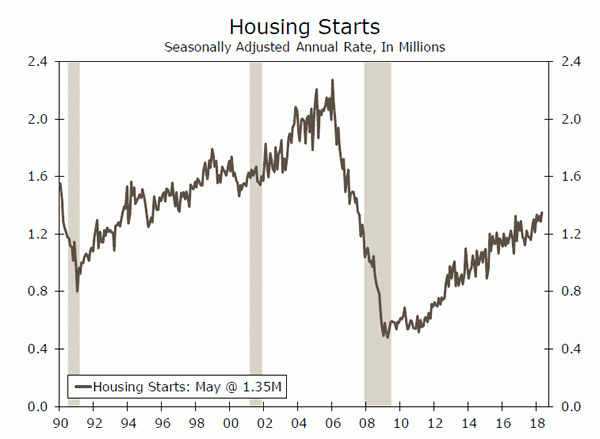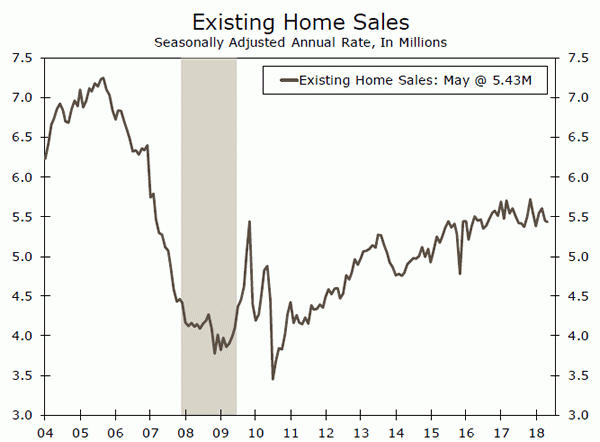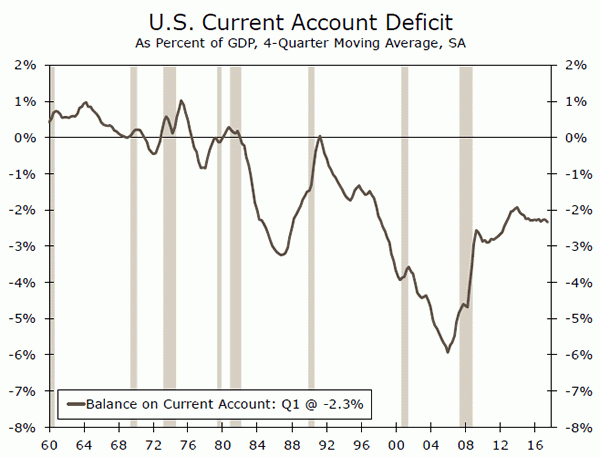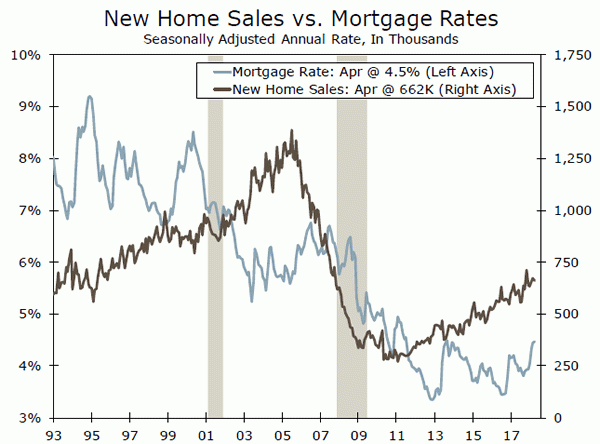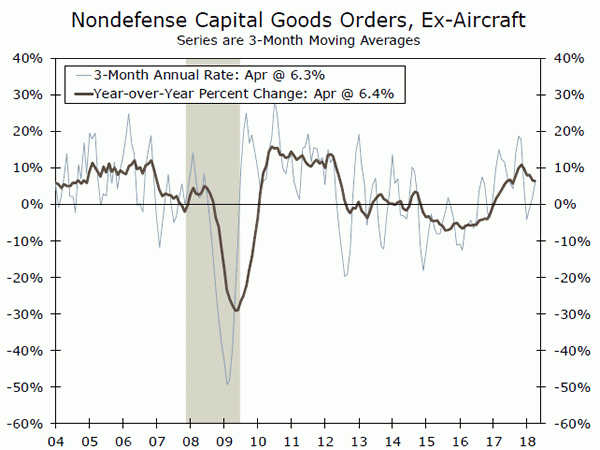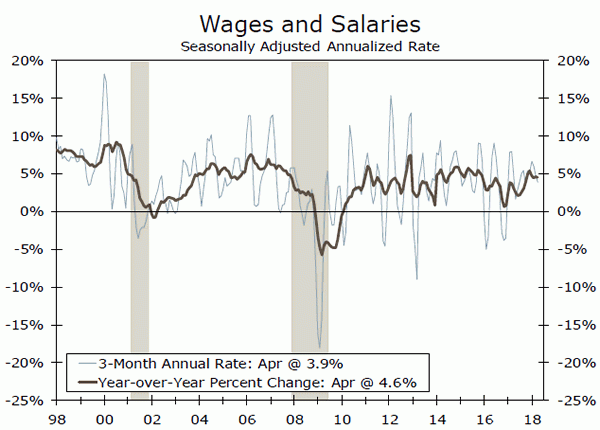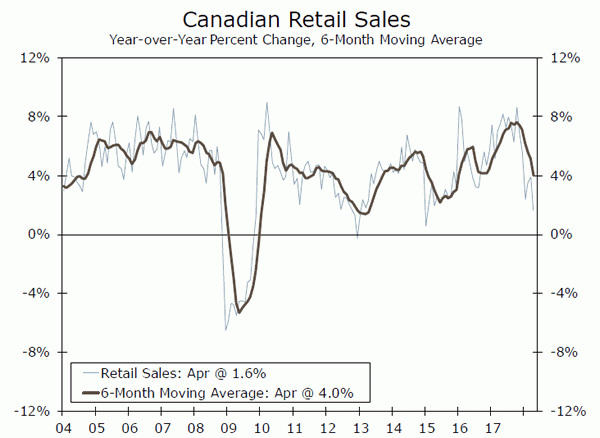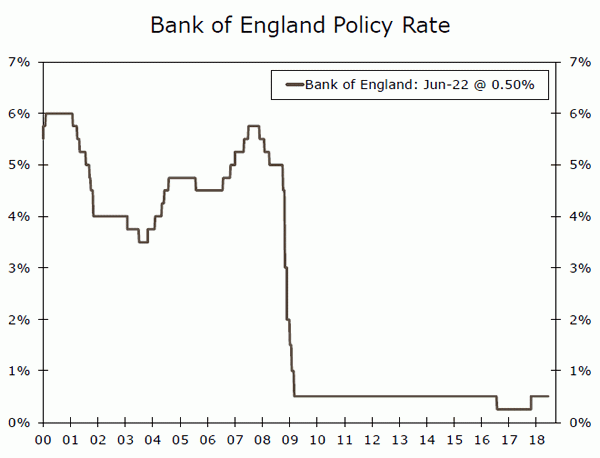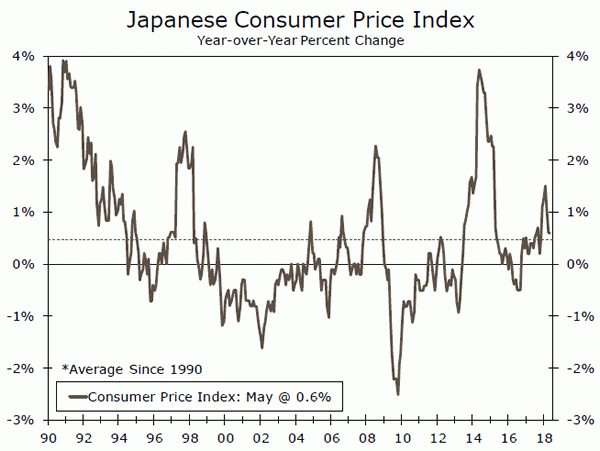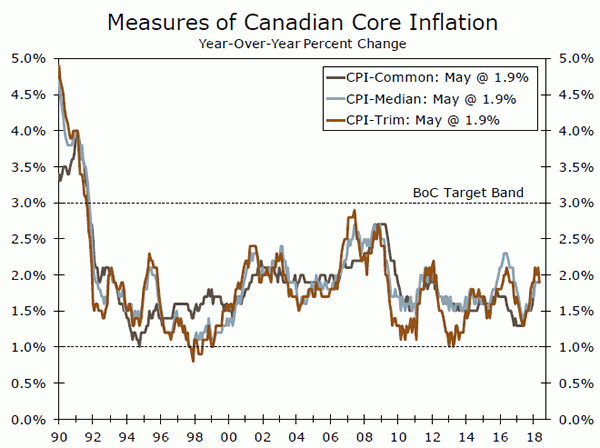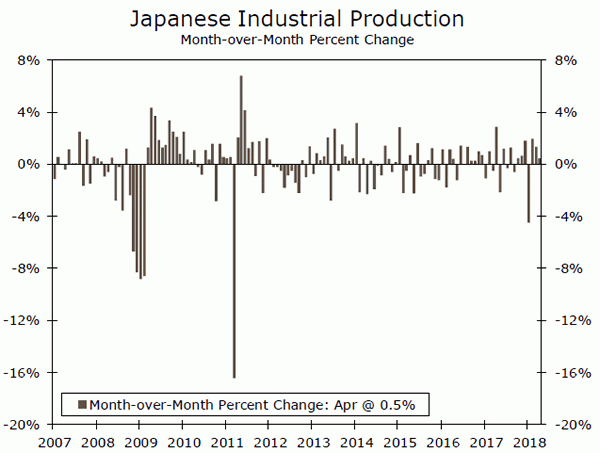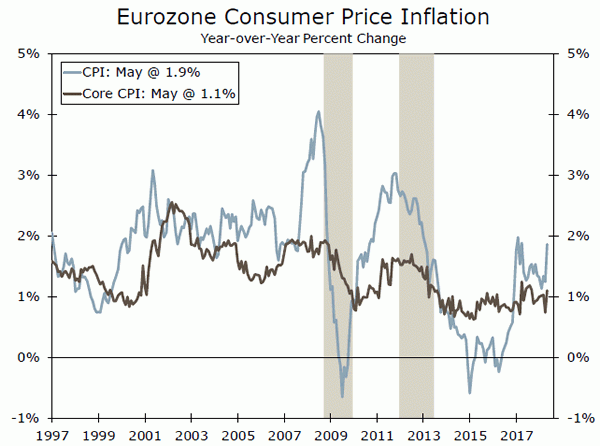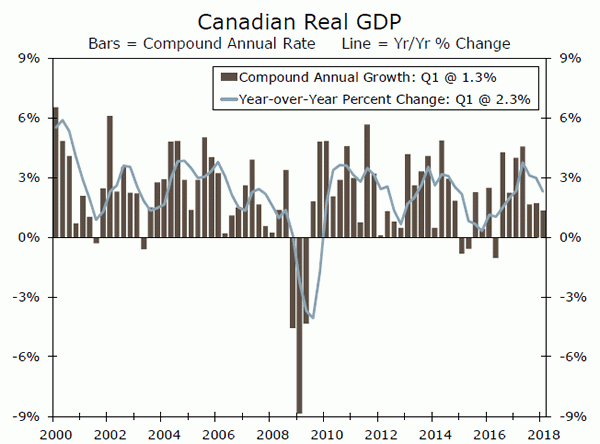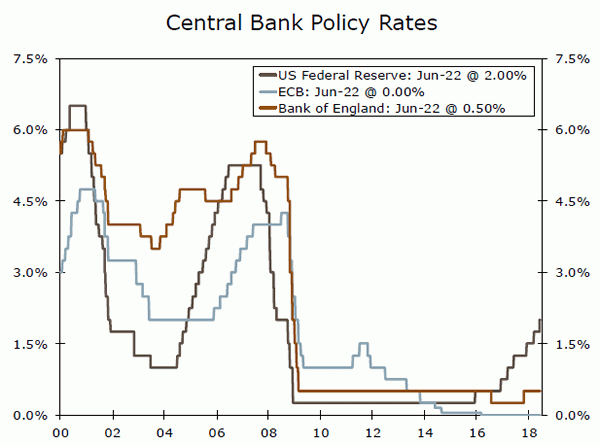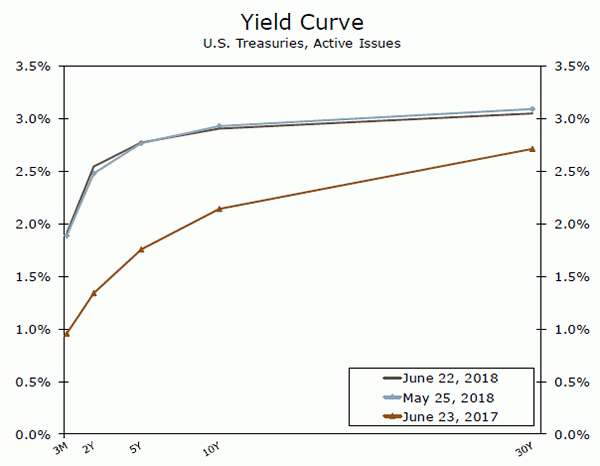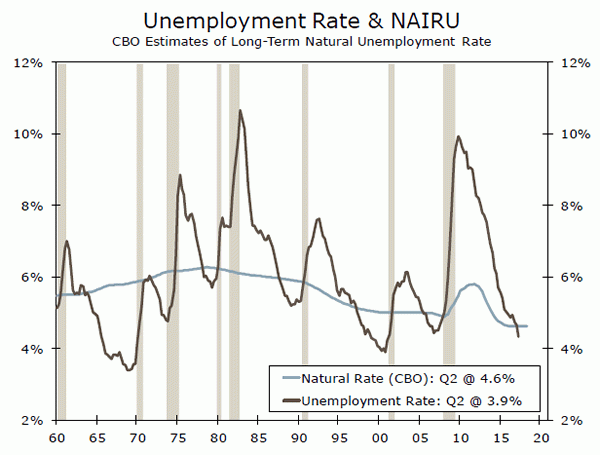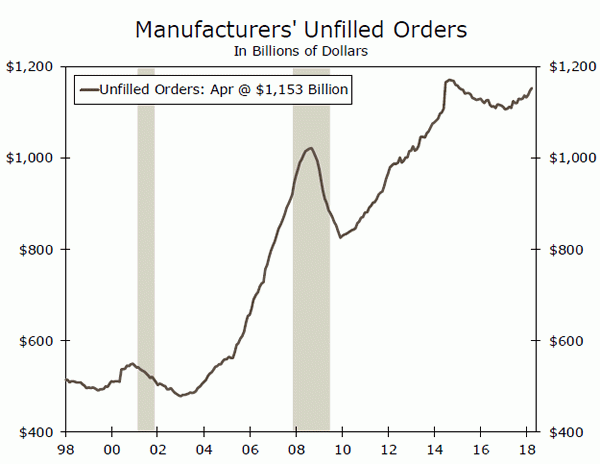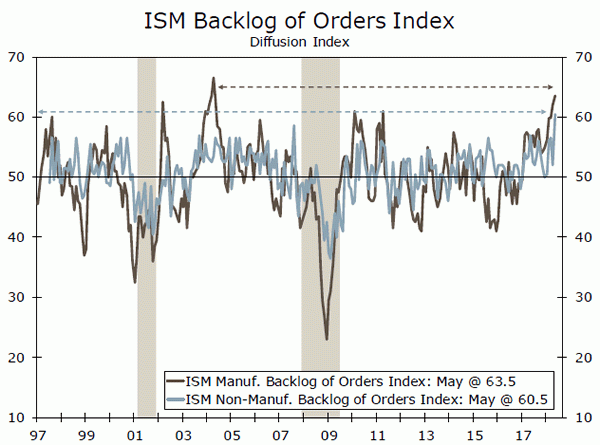U.S. Review
Housing Starts Rise as Inventory Holds Back Sales
- Following April’s upwardly-revised 3.1 percent fall, housing starts bounced back solidly in May, rising 5.0 percent to a 1.35 million-unit pace. Existing home sales fell for the second straight month in May and have fallen 3 percent over the past year, while inventory of homes for sale has fallen over 6 percent.
- The current account deficit widened in Q1 following an upwardly-revised Q4. As a percent of GDP, the deficit has remained between 2 and 3 percent over the past several years, indicating that the economy is growing at about the same pace as the deficit.
Housing Starts Rise as Inventory Holds Back Sales
Housing starts bounced back solidly in May following April’s upwardly revised 3.1 percent fall, rising 5.0 percent to a 1.35 million-unit pace. Both single-family (+3.9 percent) and multifamily (+7.5 percent) starts rose, but total permits fell 4.6 percent to a 1.30 million-unit pace. Not typically the load carrier, the Midwest drove starts this month, surging a massive 62.2 percent. Starts in all other regions fell in May, most notably dropping 15 percent in the Northeast, with smaller drops in the South and West. The huge jump in the Midwest is likely due to a later-arriving spring this year, which allowed builders to have a stronger-than-usual May. The region’s economic growth has improved significantly over the past year, largely due to manufacturing growth, and we look for further ramping up in Midwestern homebuilding in coming months. Across the country, builders continue to struggle finding lots and workers to meet the high level of housing demand. Rising lumber and materials prices are holding new construction back from reaching a faster pace.
Existing home sales fell for the second straight month in May, slowing 0.4 percent to a 5.43 million-unit pace. Once again, the drop was due entirely to a slowdown in single-family homes, which fell 0.6 percent. The Northeast was the only region in May to see an accelerating sales pace in May, rising 4.6 percent. However, sales in this region are still 11.7 percent below the pace of this time last year. Inventory has risen slightly, climbing 2.8 percent to 1.85 million homes, but has fallen on a year-over-year basis for the past 36 months. Low inventory levels are clearly still holding back existing home sales—existing home sales have fallen 3 percent over the past year, while inventory of homes for sale has fallen over 6 percent.
Following an initially reported $128.2 billion current account deficit in Q4, financial markets expected further widening in Q1. The account balance came in at $124.1 billion in Q1, but due to revisions to Q4 data, this represented a widening of $8.0 billion over the quarter. Though the deficit has widened once again, we do not view this as a headwind to growth. As a percent of GDP, the deficit has remained between 2 and 3 percent over the last several years, indicating that the economy is growing at about the same pace as the deficit. Foreign purchases of Treasuries and U.S. corporate securities have been positive in each of the past five quarters. Our baseline expectation is that the current account deficit will continue widening as the trade deficit widens. Potential protectionist trade policies throw in some risk to this outlook, however.
The Leading Economic Index (LEI) rose 0.2 percent in May, following a strong April. Most of the components in the index increased, however the recent moderation suggests positive, but slowing growth. The drags on the LEI this month surrounded the labor market and construction activity. The ISM new orders component led the index in the month, increasing 0.17 percentage points, suggesting broadening economic growth. While the index has risen, it is rising at a moderating pace, suggesting future economic growth will moderate.
U.S. Outlook
New Home Sales • Monday
Stronger job and income growth appear to be driving demand for new homes as sales are off to a solid start this year. The previous month saw sales slip, declining 1.5 percent to a 662,000-unit pace. Home sales, which have been largely driven by activity in the West, did not see as much incremental improvement in April as they usually do, resulting in the seasonally-adjusted headline drop.
Despite the monthly drop, new home sales were up 8.4 percent yearover- year, a testament to the more robust, longer-term trend. A silver lining in the April report was that sales of homes not started were the strongest in five months, which bodes well for housing starts in coming months. The market expects a rebound in sales in the Monday release, calling for a 669K annualized pace of new home sales in May. We will be keeping a close eye on home buying activity, especially while the Fed continues to hike short-term rates.
Previous: 662K (SAAR) Wells Fargo: 657K Consensus: 669K
Durable Goods • Wednesday
Despite last month’s drop in durable goods orders, core capital goods orders are improving on trend. The 1.7 percent drop experienced last month was largely a result of a 30 percent plunge in aircraft orders, which caused transportation orders to contract 6.1 percent. Because transportation orders are notoriously volatile month to month, the year-over-year measurement is more telling, as it has risen 12.1 percent. Likewise, ex-transportation orders have gained some momentum since the start of the year, notching a 0.9 percent gain in April.
Moreover, several regional Fed manufacturing PMIs have already been released for May, and all showed growth accelerating from April. While business spending is not likely to grow at the booming rate indicated by the PMIs, we anticipate equipment spending will strengthen in the second quarter.
Previous: -1.6% (Month-over-Month) Wells Fargo: -2.1% Consensus: -0.4%
Personal Income • Friday
Personal income jumped 0.3 percent in April, driven by strength in wages and salaries. The trend in wage and salary growth has clearly firmed in recent months on continued strong demand in the labor market, which has helped support income gains and consumer confidence. Such confidence has supported stronger spending on future income gains in recent months, and the saving rate has declined to 2.8 percent from 3.0 percent in March. Tax cuts may have also supported the surge in recent spending, as larger paychecks continue to boost disposable income.
With inflation showing nascent signs of enduring firmness, employers may begin to demand higher wages to maintain purchasing power. Likewise, with an increasingly tight labor market, employers’ hands may be forced to offer higher wages to attract and retain top talent. Multiple forces are at play which suggest higher income growth in the coming quarters.
Previous: 0.3% (Month-over-Month) Wells Fargo: 0.4% Consensus: 0.4%
Global Review
Canadian Stir-up
- In Canada, a soft print for CPI inflation and indications of deterioration in retail spending take some of the wind out of the sails for rate hikes from the Bank of Canada.
- Meanwhile, the Bank of England kept rates on hold but there is dissention in the ranks of the Monetary Policy Committee. The decision to remain on hold was split (6-3), as a growing number of MPC members indicate a preference to hike rates.
Prelude to a Hike at the Bank of England
At its earlier meeting on May 10, the Bank of England (BoE) opted to maintain its policy rate at 0.50 percent after a lackluster first quarter GDP report. The vote was 7-2 at the time, with the dissenting votes citing a preference to go through with a rate hike despite the softening economic data.
The number of dissents climbed to three in this week’s (6-3) decision to keep the overnight rate on hold at 0.50 percent. In our view, odds are now better than even that the Monetary Policy Committee will lift interest rates at its August 2nd meeting.
A sudden deterioration in the vital economic statistics for the U.K. economy could upset that plan, but considering the fact that the purchasing manager surveys are still firmly in expansion territory that does not seem terribly likely. The BoE, along with many other central banks, appears committed to normalizing policy.
No Urgency in Japanese CPI Data
Despite this current of normalization, the Bank of Japan (BOJ) is still swimming against the stream. At its June 14 meeting, the BoJ announced its intention to maintain its comprehensive package of asset purchases and yield curve control.
The primary objective for the Bank of Japan is to achieve 2 percent CPI inflation. At the end of this week, we learned that May CPI inflation in Japan came in at 0.6 percent. That is a right in line with the 0.6 percent reported in April and the 0.6 percent that had been expected. Core CPI inflation also came in at 0.7 percent in May.
Japanese GDP slipped in the first quarter, but we expect the economy to return to its growth path in the current quarter. The pace of that growth is still expected to be only incremental. With growth tepid and inflation benign, there is nothing compelling policymakers in Tokyo to let up on their comprehensive package of accommodative monetary policy.
Canadian CPI and Retail Sales
The May 30 statement from the Bank of Canada (BoC) adopted a moderately more hawkish stance, and potentially signals a faster pace of rate hikes ahead than previously anticipated. However, long-standing concerns about high levels of household debt and unsustainable levels of residential investment are still a concern.
Data released this week shows that consumer spending hit a soft patch, with core April retail sales figures showing a 0.1 percent dip in the month. The broader measure of spending which includes autos dropped 1.2 percent.
The BoC aims to keep CPI inflation at the midpoint of an acceptable range of 1 to 3 percent and it also considers multiple versions of “core” inflation for considering pricing dynamics. The latest batch of inflation numbers for the month of May came out on Friday. All of the core measures came in at 1.9 percent which give the BoC cover to raise rates at its upcoming meeting on July 11.
That said, headline inflation came in a little softer than expected; that combined with the soft retail sales figures take away some of the urgency for a subsequent hike later this year.
Global Outlook
Japanese Industrial Production • Friday
Real GDP in Japan contracted at an annualized rate of 0.6 percent in Q1-2018 due in part to the 5.3 percent nosedive in industrial production (IP) in the first quarter. However, IP has now grown for three consecutive months, which puts GDP growth on a path to return to positive territory in the current quarter. Data on Japanese IP in May are scheduled for release on Friday.
Other data releases for May that are also on the docket next week will give analysts information that they can use to tune up their GDP growth estimates for Q2. Data on retail sales will offer some insights into the current state of overall consumer spending in Japan, while data on housing starts and construction orders will paint a clearer picture of the health of the construction sector. June data on consumer price inflation in Tokyo can be used to gauge the overall rate of CPI inflation in Japan at present.
Previous: 0.5% (Month-over-Month) Consensus: -1.0%
Eurozone CPI Inflation • Friday
The overall rate of CPI inflation jumped from 1.2 percent in April to 1.9 percent in May. Some of the sharp increase in the year-over-year rate of CPI inflation reflects base effects (i.e., inflation was elevated in April 2017 but depressed in May 2017). But the 2.2 percent jump in energy prices in May relative to the previous month also pushed inflation higher. Preliminary data on both the overall rate of inflation and the core inflation rate in June are slated for release on Friday.
Industrial production in Germany, which rose sharply over the course of 2017, has trended lower thus far in 2018. The Ifo index of German business sentiment in June, which is on the docket on Monday, may shed some light on the current state of the German factory sector. The German labor market report for June will be released on Friday, and retail spending data for May will also print late in the week.
Previous: 1.9% (Year-over-Year) Wells Fargo: 1.9% Consensus: 2.0%
Canadian GDP • Friday
The Canadian economy grew only 1.3 percent in Q1-2018, the third consecutive quarter in which the sequential rate of real GDP growth fell short of 2 percent (annualized). Canada is the only major country which publishes real GDP data on a monthly basis, and output grew 0.4 percent (not annualized) in February followed by 0.3 percent in March. In short, the Canadian economy came into the second quarter with a fair degree of momentum, and the GDP release for April, which is on the docket on Friday, will show how the economy fared at the beginning of Q2.
There will also be some “soft” data that will give analysts further insights into the current state of the Canadian economy. The Bank of Canada will publish survey data on the business outlook as well as its Senior Loan Officer survey, which measures the lending attitudes of Canadian banks.
Previous: 2.9% (Year-over-Year)
Point of View
Interest Rate Watch
Known-Unknowns
Monetary policymakers do not operate with perfect foresight. At times the most pressing factors to the outlook cannot be put into models, or they come with a high range of uncertainty. This week FOMC Chair Powell highlighted two factors that make the outlook less clear for the Fed and hence market-watchers.
Where Is NAIRU?
The unemployment rate currently sits 0.7 percentage points below the FOMC’s estimates of full employment. Yet, the natural rate of unemployment tends only to be determined after the fact, when wages begin to accelerate.
The last time the unemployment rate stayed as low as 3.8 percent for an extended period was in the late 1960s, when NAIRU is estimated to have been about 5.75 percent. At the time, however, estimates placed it around 4 percent, implying the economy was not nearly as overheated as it turned out to be.
Trade Tensions: Sailing in a Fog
Tit-for-tat measures have raised concerns over an all-out trade war in recent weeks. As tensions escalate, uncertainty about the outlook is starting to percolate into businesses plans for hiring and investment.
With no firm indication of the amount, makeup and timing of further trade barriers—if they occur at all—the extent of the effects on growth, employment and inflation are difficult to pin down. “We don’t have any way to know how to put [trade] in the outlook just yet” Powell said. Therefore, the current trade environment is one more factor clouding the proper path of monetary policy over the near term.
Forgoing Forward Guidance
Alongside these two known-unknowns comes reduced forward guidance. As the economy has healed, there has been less of need to pledge a certain policy stance. Consequently not only are policymakers less certain about the forecast, but they will be offering up fewer assurances about the near- to medium- term path of policy.
Credit Market Insights
Moderating Financial Expectations
The Federal Reserve Bank of New York recently released the results of its May Survey of Consumer Expectations, which showed that household financial expectations deteriorated slightly over the month. While various sentiment measures suggest that consumers still remain broadly confident about current economic conditions, future expectations have moderated slightly.
The share of survey respondents expecting tighter credit conditions a year from now increased to more than 30 percent in May. These expectations are likely due in part to a steadily rising cost of credit as the Fed continues along its tightening path. As such, survey respondents were less optimistic about their future financial situation, with 13.7 percent of respondents expecting to be worse off financially a year from now, up from 11.8 percent in April.
Although financial expectations have moderated, household balance sheets generally remain strong, likely buoyed by rising incomes and a tight labor market. The Federal Reserve also recently released Q1 data on aggregate household financial accounts, which showed that total household net worth surpassed $100 trillion for the first time in series history. Household net worth has been steadily rising in this expansion, and should likely provide a cushion to most consumers against rising interest rates and tightening credit standards, at least for the foreseeable future.
Topic of the Week
Logjam: Tight Supply Chain Effects
There is growing evidence that the economy is experiencing some congestion in the production pipeline. Despite only modest levels of capacity utilization, an increasing number of firms are citing longer delivery times and a steady increase in unfilled orders. Businesses have been adding to inventories at only an incremental pace, while firms are more likely to cite inventory shortages in their customer inventories than they have been at any other point in more than five years.
The dwindling slack in the manufacturing sector accentuates the vulnerability of the supply chain. At various earlier points in the current expansion, events that might have caused major disruptions, from natural disasters to port closures, have caused only mild interruptions to supply chain managers because a degree of slack in the system allowed some supply chain flexibility. This is not the case today.
The current log-jammed environment stands to be supportive of stronger investment spending or higher inflation, however, upward price pressures appear more immediate. Inventory shortages, increasing input prices as well as a steady increase in unfilled orders present scope for firms to raise prices in order to maintain or increase profit margins while meeting customer demand. The Fed will monitor inflationary pressures, and it may have to adjust its path of policy if price pressures build earlier than anticipated.
We make two primary points in our recent paper. The first is that by most measures, the economy is firmly in expansion mode, but it is also more vulnerable to supply chain disruption than it has been at earlier points in this cycle. The second is that even absent any disturbance, the log-jammed environment that exists today is likely to be inflationary, perhaps more than some market participants would expect, given the otherwise benign readings for capacity utilization. For our full analysis, please see “Logjam: Tight Supply Chain Effects on Prices & Capex.”




